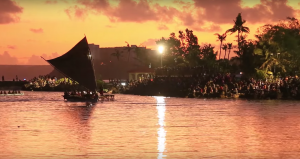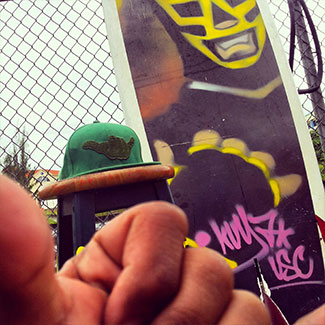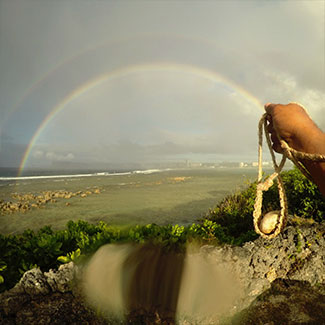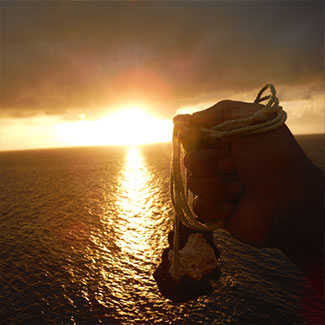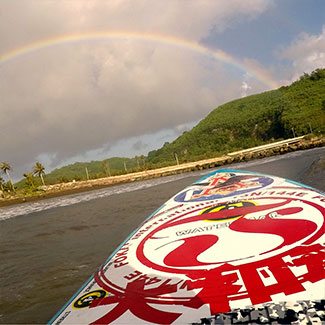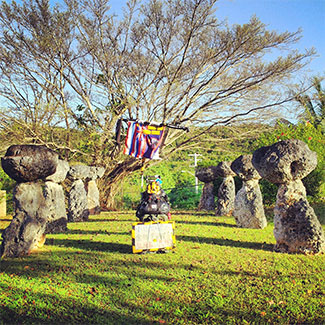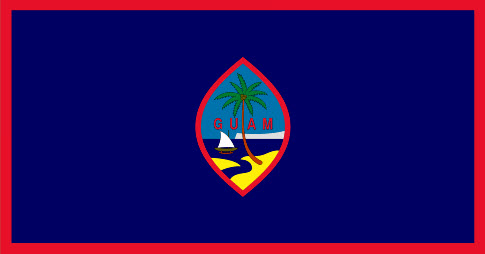Slinging Rocks: The Heritage Cup 2020
Slinging basics lesson and Some wordsin for the past, presnet, and future of Guam slinging and its conection to the 500th year anniversary commemoration of Pacific Islad mass contact with European Explorers
Tir de Fona Internacionale- 7th International Slinging Competition in Mallorca 2020.
March 7, 2020 by admin
Filed under Onra, Special Forces
Held the same weekend as The Heritage Cup in Guam last weeekend– Here is A quick video of the 7th International Slinging Competition in Mallorca 2020. The videos and photos used here have been collected together from a variety of sources
Biba! 73rd Liberation Day&TheForce Sling Cage
Hafa Adai,
wed like to take the time to honor and celebrate the sacrifice of our soldiers and citizens to give us this day of celebration.
AStone slinging was one of our ancestors primary tools for hunting, and warfare–in our distant past it was used for both sustaining and protecting our land and people.
Returning to roots in our island’ ancestors’ most widespread martial art we invite you all to give slinging a shot not nly to start slinging, but as a footstep forward into connecting and reconnecting with our past.
Thanks and prayers for everyone Liberation Day 2017
Rock on!
Thanks for dropping by
F is for FestPac: Hafa Adai & GoodVibrations
Hafa Adai,
Welcome to Guam all our visiting delegations. As an island, we are absolutelySTOKED to have you here.
FestPac2016 is modern Guam’s largest single event. Despite what might be considered imperfections from our organizers, we are happy to see that our people have more than picked up the slack.
Wether it be Guam delegate, Public Official, Spectator–We are all honored to share culture with all of you and hope your trip here leaves you with the Pacific Enchantment that makes our 170,000 in population very proud citizens.
The scheduled events have offered more than what they have promised. The accumulation of the little things we may have learned from culture to culture- has multiplied exponentially into a revitalized embrace of our unified Pacific Islander Family.
Words cant express what happened in between the carvings, scultures, paintings, woven items, song, dance, costume.s, and performances. This has all been great but what really takes the cake is what has happened with real person to person conversations.
“I Todu i tiemp i Pas Para Hita”
“In all times Peace for us” in our national anthem translates also into May ever lasting Peace reign over us ”
–though this has been sung primarily for the People of Guam–we can proudly say that this prayer extends to our brothers and sisters in Island Living.
American Samoa, Australia, Cook Islands, Easter Island, Federated States of Micronesia, Fiji Islands, French Polynesia, , Hawaii, Kiribati, Marshall Islands, Nauru, New Caledonia, New Zealand, Niue, Norfolk Island, Northern Mariana Islands, Palau, Papua New Guinea, Pitcairn Islands, Samoa, Solomon Islands, Tokelau, Tonga, Tuvalu, Vanuatu and Wallis and Futuna—
Guam is proud to have hosted such honorable delegates. With the several thousand of you that arrived–so came with you your ancestors.
The Spirits of our Lands have come together to join in the Spirit of a Unified People.
May the value all our cultures persevere over the conveniences of modern technology so that we enforce the legacy of our ancestors, that we never lose the intimacy with our mother earth and our father above, and that we keep alive the ways of island living.
May we live and grow from this heaven-sent experience, and that we build from the foundations of culture sharing for the fluorishing and constand reenforcement of this Pacific Islander Nation.
Thanks for dropping by.
May the Force we with you all.
Pena wins Marianas Open, receives $10,000 prize
Pena wins Marianas Open, receives $10,000 prize
Marianas Open defending champion Keenan Cornelius faced off against Felipe Pena in the final of the Absolute Black Belt Championship on April 16 at the Father Duenas Memorial School’s Phoenix Center, losing by a 4-2 decision.
Pena and Cornelius had fought only once before, and that time it was Cornelius who was awarded the win by decision.
Pena was determined not to let the prior loss affect this fight and came out strong, earning two quick points by sweep. Cornelius responded with a sweep of his own, leaving an even fight until the seventh minute. Pena was able to get one last sweep to take control for the final three minutes, and was named the new Marianas Open Champion. Pena was awarded the $10,000 cash prize for first place.
“I’m really happy to be here,” said Pena. “To have gone out there and win, it’s a really good feeling. It was great being in Guam. I love the people, the island and I am looking forward to defending the title next year.”
Marianas Open founder Steve Shimizu was impressed with how competitive all of the fights were, including the championship bout between two of the best fighters in the world. His goal was to send the message that Guam is a place for competitive jiujitsu fighters to come to, and he believes that message was sent.
“It shows that jiujitsu can go any way,” he said.
“You have the reigning champion get dethroned, but they fought hard. It shows that the level is here. Guam is the place for them to come now and they know that we do just as good of a job as anywhere else in the world.”
Cornelius was awarded $3,000, while third-place finisher Igor Schneider was awarded $2,000. Schneider fought against Guam native Terrence Aflague, going up 29-0 and finishing it with a submission by armbar.

PACIFIC DAILY NEWS
Preba Hao “Prove Yourself” features 14 fights
Semifinal
Prior to winning the championship, Pena defeated Aflague in the semifinal bout. Pena was able to rack up seven quick points, passing guard into a mount. From there, Pena wore Aflague down until he was able to get him in a bow and arrow position, leading to a submission.
The other semifinal fight, between Cornelius and Schneider, also led to a bow and arrow submission, though the fight was more evenly matched, with Cornelius landing only two points by sweep prior to the submission.
First round
The first fight of the day was between Pena and Guilherme Augusto Santos. Santos put up a good fight against the future champion and it wasn’t until the final minute that Pena was able to earn two points by sweep and win the fight.
Aflague faced Joel Bouhey for the second fight of the day, winning by a score of 3-0. The fight began slow with the fighters in a 50-50 guard, but Aflague was able to pass guard about six minutes in and earn the three points he would need to advance to the semifinals.
Cornelius faced Jacob Guerrero of Barrigada in the first round of fights. Guerrero stepped up to fight on short notice after Rhalan Gracie withdrew Friday night due to an injured right knee. Unfortunately for Guerrero, he was mismatched against Cornelius and lost by submission after a painful bicep slice.
The third Guam fighter, Bryant Pangelinan, was matched against Schneider for the fourth fight of the day and final of the first round. Schneider was able to control Pangelinan after a sweep into a back mount gave him the position he needed to win the fight by a 6-0 decision.
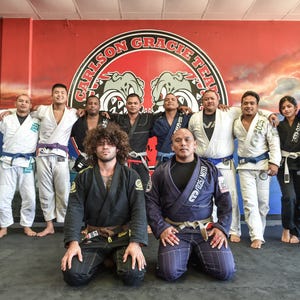
PACIFIC DAILY NEWS
Carbullido wins double gold
Brown belt
Nick Calvanese won the Absolute Brown Belt division — and airfare, hotel accommodations and registration entrance fee into the Pan Asia BJJ tourney in the Philippines in May.
Guam Representative: Terrence Aflague on Budo Videos
Coach Terrence Aflague of Purebred Guam has trained his entire jiujitsu career on island. A family man, a father of 3 with a full time job–he still finds time and resurce to compete in larger tournaments off island. Her he offers some words of what it means to compete for the second at this level in his hometown
Black belts ready to fight at Marianas Open
April 15, 2016 by admin
Filed under BJJ Stuff, Onra, Special Forces
The Marianas Open brought some of the top-tier talent in Brazilian jiujitsu to Guam to compete in the Absolute Black Belt Championship — eight competitors from all over the world, including 2015 Marianas Open champion Keenan Cornelius.
“It’s always a pleasure to come back to Guam,” said Cornelius. “I’ve been here three times now and I like it more and more every time. I actually train with a lot of tough guys from Guam. I think Guam is the melting pot of jiujitsu for the Pacific, so it’s great to be out here and compete with all those guys. The jiujitsu is really strong out here and I think it’s only getting stronger.”
The Marianas Open faced a setback Friday afternoon, when it was announced that another high-profile fighter, Rhalan Gracie — grandson of Helio Gracie, the founder of Brazilian jiujitsu — would be unable to fight due to a knee injury. Gracie’s knee had been previously injured but he was planning on making his return here in Guam. Gracie initially said that he was 50-50, but later determined that he couldn’t fight.
Though he’s disappointed he won’t be able to fight, he has enjoyed his time on Guam.
“One thing about the island lifestyle, they love jiujitsu, they love the fighting arts. They are very passionate about that,” said Gracie. “I think it’s a very good place to be and people have taken very good care of us. If you guys keep doing what you’re doing, there’s nothing but success up ahead.”
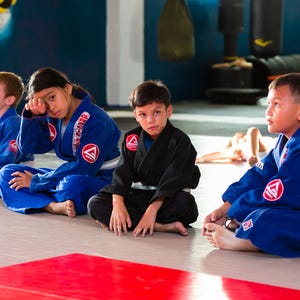
PACIFIC DAILY NEWS
‘A gentle art’
Though not originally scheduled to fight, Guam native Jacob Guerrero was able to step up at the last minute and fight in place of Gracie.
Guerrero will be facing off against Cornelius in the first round.
Along with Guerrero, two other Guam fighters will be participating in the Marianas Open. Bryant Pangelinan was born in Guam, but currently lives and trains in Concord, California. Terrence Aflague was born in raised in Yona, where he still resides and has trained since 2001.
“Competing for the Marianas as a homegrown black belt, this is a big opportunity for me,” said Aflague. “I don’t have to travel or leave the island. I just had to jump on this opportunity and drive from Yona to Mangilao and mix it in with these guys.”
For Pangelinan, having the opportunity to come home and fight is something he’s looking forward to.
“It’s an honor to be asked to come home and fight,” he said. “After always wanting to compete on Guam, it’s almost come full circle so it’s nice. The vibe is great, everything has been perfect, and I’m just ready to get out there and represent Guam.”

PACIFIC DAILY NEWS
Carbullido wins double gold
Three of the fighters — Felipe Pena, Guilherme Augusto Santos and Igor Schneider — traveled all the way from Brazil to fight in the Marianas Open. Santos and Schneider, both new black belts, said they were excited to be on the island and were looking forward for the opportunity to pull off an upset.
Pena, however, could perhaps be the favorite to take the championship from Cornelius, though he did lose to him in the pair’s only previous meeting. A former world champion, Pena’s already claimed the European Open Championship this year. He’s enjoyed his time on Guam so far, particularly his trip to Cetti beach, but had to admit he was a caught off guard when he got the invitation to fight in the Marianas Open.
“To be honest, jiujitsu here has surprised me a lot,” said Pena. “When I got invited, I looked at the map and saw a really small island and said, ‘Man, I didn’t even know there was jiujitsu there.’ I got here and so many tough guys, a lot of black belts, and I’m happy to be a part of this tournament. I think you guys are doing a great job bringing all the athletes here.”
Along with the chance to fight in paradise, the $15,000 purse was a huge factor in getting these talented fighters to Guam. The goal is that offering big prize money will bring fighters to Guam, and in return the island’s jiujitsu scene will grow even larger.
Cornelius said from what he’s seen the past couple years, that goal is well on its way to being accomplisched.
“I think this tournament is probably one of the biggest things helping bring eyes to Guam and also helping promote jiujitsu as a whole all around the world,” he said. “This would be considered one of the top-tier tournaments for offering prize money. You guys are already on par with some of the best jiujitsu tournaments in the world. I think that’s why you are attracting such talented athletes.”
The Marianas Open is being held Saturday at the Father Duenas Phoenix Center in Mangilao. Doors open at 8 a.m., with the Absolute Black Belt Championship beginning at noon. Tickets are $15 for adults and $10 for kids.
MARIANAS OPEN
BRACKET ONE
- Felipe Pena (BRA) vs Guilherme Augusto Santos (BRA)
- Joel Bouhey (USA) vs Terrence Aflague (GUM)
BRACKET TWO
- Keenan Cornelius (USA) vs Jacob Guerrero (GUM)
- Bryant Pangelinan (GUM) vs Igor Schneider (BRA)
The winners in each bracket will fight, with the winners of those fights contesting for the championship.
SinceEverSince:Naton
The following is ongoing coverage with accumulated articles regarding the Mariana Islands most significant archaeological finds to date
Roughly a decade ago, during renovations for the at-the-time Okura Hotel in Tumon, graves were surprisingly found to unfold the iscovery of a massive gravesite consisting of 3different levels –unheard of in the Mariana Islands. With gravesites and jewelry estimated to be at least 2500 years or older–this historic find of more than 400 sites is still absent of any recognition–even though it sits right inside our main tourism district.
Follow us here and Use the Force as we launch our own investigation to collaborate with the like-minded for justice for these people
Archaeologists: Two waves of Chamorro migration
Archaeologists have reason to believe that ancient Chamorros came from two waves of migration. On Tuesday, archaeologist Judy Amesbury presented findings from the Naton Beach excavation to the Rotary Club of Tumon Bay. The excavation took place nearly a decade ago, but the three-volume report was just released.
At Guam’s Naton Beach site in Tumon Bay, archaeologists found more than 400 burials from the Pre-Latte Period and Latte Period of Guam. More than 150 burials from Naton Beach were from the Pre-Latte Period and marked the largest number of burials from that time, as well as the earliest burials ever seen in the Marianas. According to Amesbury, this was the most significant excavation in the Marianas because of the very large number of early people.
The Pre-Latte Period is from 1,500 B.C. until latte stones were introduced. The Latte Period started around 1,000 A.D. and ended with Spanish contact in the 16th century.
More than 20 years ago, the archaeological company Micronesian Archaeological Research Services did an excavation in Saipan and found more than 500 cone shell beads and fragments of bracelets that dated back 3,500 years or more. No human remains were found with these artifacts, so archaeologists weren’t able to connect the ornaments with the people until excavating the Naton site.
“The number of burial goods is extraordinary,” said Amesbury when describing the Naton site. About 1,700 ornaments were found on human remains. These ornaments consisted of beads and bracelets made from shells and shark teeth. One burial contained glass beads, which indicated it took place after Spanish contact. Glass beads were made in Europe and were brought over from Spain to trade with the Mariana Island inhabitants.
Pre-latte ornaments mainly consisted of three types of cone shell beads — the same types found at the earlier excavation in Saipan — and beads made from clam shells, bracelets, and tiger shark teeth necklaces. Other types of adornment found were inlaid teeth and the use of an earthy pigment called ochre. Over 98 percent of the ornaments found at Naton were from pre-latte burials.
The remaining 2 percent of ornaments came from Latte Period burials. These ornaments consisted of cone shell beads, including a type that was a different shape from the pre-latte cone shell beads. Beads made from the spondylus shell were found. What appeared to be teeth from the silky shark were also found in the latte burials. Inlaid teeth weren’t found in latte burials, but eight burials revealed teeth with incised patterns of horizontal, diagonal or cross-hatched lines.

PACIFIC DAILY NEWS
Dig offers clues to past
The distinct differences between ornaments from pre-latte burials and latte burials support the hypothesis that two waves of migration occurred in Guam’s history. Last month, molecular anthropologist Miguel Vilar presented evidence from his study of DNA from living Chamorros that also supports the hypothesis. In addition, dental analysis of the remains found at Naton indicates a statistically significant difference between teeth from pre-latte burials and latte burials.
“(Archaeologists) never knew if the latte stones were just in seed to cultural development that the people thought of making after a while or if it was a new group of people coming in,” said Amesbury. “And now it looks like a new group of people. So that’s very interesting to know that there was more than one wave of migration.”
When people ask where the Chamorros come from, Amesbury is more confident to say, “It wasn’t just one boat full of people.”
Amesbury works for the Micronesian Archaeological Research Services and has been working in the Marianas for over 25 years. Her area of expertise is in the analysis of faunal remains, such as shell artifacts. She wrote numerous reports and publications about fishing and invertebrate collecting in the Marianas. She plans to publish a new booklet about the ornaments of Naton Beach. The Guam Council on the Arts and Humanities Agency and the Guam Visitors Bureau provided Amesbury with a grant to make a website and display in time for the Festival of Pacific Arts
for additional links:
http://www.kuam.com/story/31172960/historic-discovery-detailed-in-excavation-report
http://www.pacificnewscenter.com/local/7861
TEAMWORK: Nova Uniao
After ging undefeated, Jose Aldo, former UFC 145lb. Champion, took his first loss against a fight more than a year in the making agains”TheNotorious” Conor McGregor.
Critcs, fans, and keyboard warriors from around the world have chimed in ridiculing Aldo for his 13 second loss and his chances for an immediate rematch.
In the heat of the MMA moment, as fans, we get consumed in the excitement and often forget the struggles that accomplished fighter-athletes have made on their climb to the stop or even to the bottom of the pool.
Here is an open letter to the public from Aldo’s longtime coach and more following Aldo’s very disappointing loss against the new UFC 145lb. Champion.
I have a deep sense of loss at this moment. Not only because of Jose Aldo’s belt, but mainly because of the lack of respect to our great champion, who maintained the UFC belt for four years and seven months, for seven fights (not counting his almost two years and three fights with the WEC title). I got back (to Brazil) and saw comments from people that certainly don’t know anything about fighting. And if they do, they never got anywhere, because those who achieved something in our sport know how hard is to compete at the highest level, against athletes from all over the world, and defeat them for many years.
When Brazil had no other champion, in a tense moment, Aldo maintained his title. After that, two other Brazilians joined him, maintaining the fame and recognition of the country in MMA. The only thing I ask everyone is respect to our great champion. For those who say it was fixed, I’d rather not comment, because they don’t deserve time and attention.
Last Saturday, Jose Aldo lost his belt in a fight in which he couldn’t show how well trained and prepared psychologically he was. There was no taunting that could enter his head, there was no technical failure, just an unusual blow. A blow like that, connecting in someone’s chin while moving forward, isn’t something that happens all the time. But it has happened with us. If it was the opposite, with McGregor being punched in the chin and Aldo in the eyebrow, we would be calling Aldo a superchampion today, the best of all times, but this is how sports are. Better luck for McGregor, who won and, therefore, is the new champion.
We need to understand that Jose Aldo is a human being subject to defeats, like any other. Those who show up criticizing him should think: this guy came from Manaus to Rio with nothing, to live in a gym, sleep on the mat, and wake up late so he wouldn’t starve since he had no money to have breakfast. He got where he were, always believing he would be a champion, and became one, due to hard work and dedication. The people’s champion.
Would those who are out there criticizing, talking about embarrassment, have the courage to do what he did? I bet not. If they did, they would know how hard is to win in a country where it’s rare to have support to sports. My message to critics is this: get up from the chair, get out from the computer, drop the phone, and do better. We need more people like Aldo and less critics from the couch.
The king has left, but will be back shortly.
Andre Pederneiras, Nova Uniao leader. More than a team, a family
Onra:PXC1
Hafa Adai,
Heres a write up for Pacific Xtreme Combat 1 to highlight their 50th headline event in Guam for December 4th. Respect for everyones opinion on this but we remember things a little differently.
Thank you to all the Supporters and Sponsors of Jungle Rules, Fury FC, and Fury FI..
In the world industry of professional fighting though only a few people get the official title but heres the truth…There are many ways to be promoters of Mixed Martial Arts.Thanks for all you have done, are doing, and aspire to do for martial arts and its positive contributions to and for our people.
Sinceeversince…TEAMWORK!
Thanks for Dropping by.
frm www.guampdn.com
by Grant Wieman
Pacific Xtreme Combat will hit a new milestone this weekend when the local promotion records its golden anniversary. PXC 50 will feature a handful of off-island fighters, two title bouts and a number of promising young fighters who can realistically dream of some day reaching the highest level of mixed martial art, the UFC.
The journey from the first professional full-contact fights in Guam to now has seen several promotions pop in, pop up and fade, but the PXC has continued to thrive. Unorganized street fights and backyard grappling sessions kicked things off more than 20 years ago.
John Calvo, MMA pioneer: It was just like a private club. We had our little jiujitsu club with Dan O’Connor as our head instructor. That was going on for maybe two years or three years until Dan had gone off to pilot school. Then my man Melchor (Manibusan) came back from Australia. There really wasn’t much of a scene. We just trained back yards.
Roman Dela Cruz, Fury founder: In the earliest days of training, while the most of us were still focused on learning what was a shockingly new and effective form of self-defense, John Calvo, who always thought into a much bigger box, had the vision of our group of training partners hosting an event.
Joey Calvo, PXC president and co-founder: I was living in California and actually watched the first UFC and was looking around for different jiujitsu gyms. … Ralph Gracie opened a gym in Mountain View that was like 10 minutes away. I trained there for a year and I moved to Guam in 1995. It was just garage training. You would fight anyone, these garage guys. I was playing in the Miller Football League at the time, too. We would invite these big football players back to the garage and pull out the mats and practice jiujitsu against these big football players. Jiu-jitsu would always win out. One or two minutes is all it takes.
Eli Monge, PXC vice president and co-founder: There was so much local talent on Guam.
Stephen Roberto, PXC 1 fighter: The first fight was SuperBrawl.
T. Jay Thompson, SuperBrawl promoter: I started in 1995 in a little bar (Gussie L’amour’s) in Honolulu completely sort of by mistake. The bar owner and I had both seen this crazy stuff on TV (UFC Superfight). … Eventually I found a promoter who had wanted to do a bigger show at the Blasedale Arena. I did three in 1996 and one in 1997. There was obviously a lot of news stories and politicians talking about it.
For a short time, the perceived violence led to controversy. Thompson had the fighters wear gloves, a decision he regrets, but the sport was eventually banned in Hawaii. He was looking to continue holding SuperBrawl promotions, but he needed a new venue.
TT: I had a friend named Chris Fernandez who had just started managing in Guam. I said, how do you think this would do if I brought it over there?
Joey Calvo: T. Jay showed up at the station and asked to meet the manager. He just wanted to buy advertising at first and he wanted to get sports coverage and video production. The video production back then was nowhere near the video production that goes into an event now. It was just a walk up at first. He wanted to buy advertising.
TT: I set up an office at the back bar of G-Spot and fighters came in and auditioned. They talked about being good street fighters, years of doing karate or taekwondo. It really was you could make up whatever you wanted and if it sounded good, you’d be thrown in.
John Calvo: The promoters were looking for guys on Guam. They had heard about people in the wrestling community and they reached out to me and Melchor. That’s pretty much it. Me and Melchor both signed up. Melchor pulled out because he was afraid he wouldn’t get a chance to go to the Olympics.
SuperBrawl 5, the first on Guam, was held on Aug. 23, 1997 at the University of Guam field house. Fights were held in a 24-foot boxing ring with minimal rules — no biting, no eye gouging and no groin strikes. There were two four-man tournaments, one for heavyweights and one for lightweights, and a main event that featured Dan Severn, the reigning Ultimate Fighting Championship winner and one of the most famous MMA fighters in the world with more than 100 career MMA bouts. Severn returned to Guam twice more, for SuperBrawl 7, held in 1998, and PXC 1.
Dan Severn, SuperBrawl 5 champion: I competed in just about every organization at one time or another. The phenomenon of cage fighting caught on like wild fire. It was like the wild, wild west. Back in the day there was no time limit, no weight classes, no rules. It was absolutely crazy.
John Calvo: Back in the SuperBrawl days it was actually pretty raw. They didn’t have a boxing commission or a fighting commission. They didn’t even know how to judge it.
T. Jay Thompson, SuperBrawl promoter: The no-holds barred fighting community was very small back then and we all knew each other. Dan ended up fighting for me 10 times probably.
DS: Guam was beautiful, rustic. It was like a step back in time. The cool part was I met a couple military personnel. They took me on base, took me snorkeling. It was a beautiful experience. … I just took a lot of long walks around different areas. I’d just be out on the beach. People would be out there playing beach volleyball, they see me; I’d jump in.
TT: It was a really easy transition from Hawaii because the fighting culture was so similar. I do remember hiring a local security firm at the field house and looking around the arena and seeing a lot more people than we sold tickets for. The talent immediately was, I wouldn’t call it high-level, because it was so brand new, but the fighting spirit was there, much like in Hawaii.
John Calvo: I won the heavyweight tournament and fought Dan Severn the next round.
TT: I was looking for a draw in 1998. I picked Big John Calvo, with two fights, to fight Dan Severn. (Calvo) is probably the original fighting pioneer for MMA in Guam that I can think of.
John Calvo: It was overwhelming, but I was convinced, “He’s a human being. Nobody is bulletproof.” That was my attitude. … It was weird because at that time the stereotypical tough guy wasn’t a guy with glasses. I was a surfer guy. It was weird for me but it was fun to get a lot of respect.
DS: I didn’t know much about him. I heard he was the island bully from a very influential family. They were young rogues, males of the family. He was one of the biggest bullies on the island and it was the perfect match we set up with this guy and I think a lot of people were happy with that I put him in his place. Or, maybe a better way to put it is, I served him up a nice piece of humble pie.
John Calvo: I didn’t know much jiujitsu. I didn’t know much of anything. I don’t know if it was ignorance or heart. It was a fun experience.
Five SuperBrawls were held on Guam, concluding in October 2000. By then, Thompson had successfully found a loophole in the Hawaiian laws that allowed him to promote more fights in his home and a new figure had stepped up to hold fights on Guam. Roman Dela Cruz, founder of Fokai Industries, began holding Jungle Rules in August 2001, but the business opportunity quickly drew in other challengers. A group from KUAM and Tropical Productions stepped into the fold in 2003. Dela Cruz’s Jungle Rules evolved into Fury Full Contact Fighting, sponsored by Budweiser.
Roman Dela Cruz, Fury founder: After hosting a few submission grappling events and feeling the faith and support of the community, we felt the local movement for local fighter athlete development was served best by the hands of the people effected most directly by it. After a long talk with Enson Inoue and TBoogie Anderson, after a heavy day of training at Purebred Shooto Gym Guam, we decided that the dream was worth the effort and got the wheels turning to make it happen.
Stephen Roberto, PXC 1 fighter: Roman Dela Cruz, John Calvo and Tony Anderson teamed up together to form Jungle Rules.
RDC: Although there might be a few names widely recognized for Jungle Rules, it needs to be said that the event was a product of the combined effort; a large group of close friends that had high hopes for Guam fighters, including the fighters themselves.
TT: I really enjoyed promoting in Guam and I love the culture and the people. I completely enjoyed the amount of time I stayed there.
RDC: Fury was created largely because there were no events in Guam. Jungle Rules 1 and 2 were executed properly enough that the prior promoter figured that he’s better off staying busy in other places. He saw that local promoters had filled that gap. And without all the moving parts for Jungle Rules 3 in line, Fury was born.
TT: They were businessmen, so it wasn’t going to take long. They weren’t going to let some haole businessman jump from Boston to Guam. Somebody locally wanted to do their own show and I didn’t want to fight it. I had so much going on, bigger shows (in Hawaii). I probably wouldn’t have stopped going, but I’m not bitter about it.
Eli Monge, PXC vice president and co-founder: When Joey (Calvo) and I started PXC, we were just in love with doing martial arts. We wanted to set a stage to showcase some of the local talent. There was so much talent on Guam.
Joey Calvo: Eli and I were both into jiujitsu. We knew all the local guys. We trained with them. In three or four months, we put it together. It wasn’t really a lot of had work. We were doing it already and then our sister company, Tropical Production, they were doing concerts so we had all the resources for sound and lights.
EM: I had an office at KUAM. (Joey) walked in and he was just fed up with the outside promotions paying so little to the locals and that’s where it started at.
Joey Calvo: The way my family does business is a lot of collaboration. There was a little skepticism about getting into the fight game. My dad wasn’t really sure about it — there was a lot of risk and liability — but he gave the approval.
RDC: The world of competitive fighting was in thick transition from the question of art versus art to athlete versus athlete, from no holds-barred to mixed martial arts.
EM: I remember all of us sitting down and Joey telling them we were going to be doing a new promotion. Everybody starting pitching their ideas of the name. We came up with some crazy names.
Joey Calvo: Like a lot of things in my family, we do it at family dinners and brunches. It’s a collaboration of a bunch of guys in the family. We had some crazy names involving war and volcano eruptions. We wanted to mimic the UFC, the NFL, and something to brand the Pacific region.
EM: We were having lunch with all the brothers and we wanted to have Guam or Pacific in the name and that’s when we came up with Pacific X-treme Combat. A few of the brothers would say they came up with it, but it was a joint effort. I wanted some crazy stateside name.
Joey Calvo: Big John was with us back then and he came up with mocks of logos and we unanimously agreed on that, with the big red X. … We’re still using the P and the red X and the C. We’ve fine-tuned it a little bit.
SR: You’ve got the Budweiser camp and the Miller camp, and they were using the events as a way to market their products. Mixed martial arts was the hot item and they were looking to get into it.
John Calvo: Me and Roman, we stopped being partners. He went his own way to do (Fury). That’s when it became a business. It became competitive.
Joey Calvo: (Eli and I) trained with Roman a little bit. He was part of that Purebred gym in Hagåtña. We did the first (Jungle Rules). The first one was sponsored by KUAM, Tropical Productions and Miller. They went to Shimbros and Ambros after that. Roman approached us to sponsor Fury also, but we were already talking about doing PXC at that time. And then came the war of the dates.
Fury Full Contact Fighting 1, headlined by a fight between Enson Inoue and Soichi Nishida, was held Jan. 10, 2004 at the UOG Field House inside a custom-built cage. A week later, on Jan. 17, Brazilian jiujitsu student Stephen Roberto and police officer Manny Chong battled in the local main event of Pacific X-Treme Combat 1, also at UOG. Both drew a sellout crowd. Those fights were in a converted pro wrestling ring.
Joey Calvo: We set our date first and we heard a few weeks after that that they set their date. There was a little bit about, “Well, what a bunch of jerks,” but it was mostly, “Lets make sure when we throw our event, our event is better. Lets make sure the fans have a good show.” You can’t fool the fans.
RDC: The goal (of Fury) was and still is (1) to cultivate and steer MMAs positive position, path and effort for the people of the Mariana islands, (2) to provide our athletes with a quality platform in competition, (3) to showcase our islands and its people honorably to the world.
EM: We wanted just an outlet for these athletes. We wanted to create an ambiance where these guys could showcase their martial arts and their training, their fighting, a proving ground. And we accomplished that.
SR: Manny Chong and I were supposed to be the main event at Fury 1. The PXC promoters convinced Manny not to fight in Fury. I had already been training for three and a half months at that point and I was not going to let my opponent run away from me, so I ended up following him to PXC. … It was within weeks of the event. When you’re training that hard, I didn’t (care) where he was. I want to fight this guy.
Joey Calvo: We thought we did a better job marketing and promoting the event than the other guys. Not to say that that other guys weren’t successful, but we were just really over the top.
SR: PXC always focuses on the production of things and Fury was focused on the fight itself. I remember walking down, they built like, this ramp so they took out a whole section of seating to build this ramp. It was very much Pride; a lot of pyrotechnics, smoke, lights. Fury wasn’t about that.
John Calvo: PXC seemed to be putting on a more polished product. It was marketed as the premier mixed martial arts event. Right out the gate you could see the production value was on a different level.
SR: PXC tends to put a lot of backstory behind the fighters to make it seem like there’s some kind of grudge. And they really like fighters to have a nickname. I didn’t want a nickname. My name is Stephen Roberto, that’s what my mom named me when I was born. So they billed me. I was Steve “The Hitman” Roberto and it was Manny “The Enforcer” Chong. I was supposed to “take out” the cop. Fury was all about the fight. Steve Roberto, decorated jiujitsu athlete. Chong, street brawler. He was using his street skills to get himself in the (cage). It was more about your skill sets rather than our personalities. PXC always focused on the production of things and Fury was focused on the fight itself.
Joey Calvo: That just shows how hungry the fans of MMA were. With back-to-back dates, they were both pretty successful.
John Calvo: Even though it was the same venue, it felt like a whole different vibe. They had the Miller Girls. It was a lot of hoopla. The line stretched to the end of the road. It was a lot of fun.
SR: I remember walking into the field house a couple hours prior to show time and the line was ridiculous. It was jam-packed; a lot of hype, a lot of build-up prior to the fight.
Joey Calvo: It’s a lot better now, but back then it was a very challenging venue to throw an event. The concessions, the bathrooms, it’s not laid out to have an event like that. It’s hard to secure. There are many access points for people to walk in.
SR: Eli Monge tells me all the time, that was the biggest gate, the biggest attendance, of any mixed martial arts show to date. It was so frickin’ hot by the time I came out to fight in the main event I had a hard time breathing in the field house. It seemed like all the oxygen had been consumed.
EM: The first night where I sat down and looked at Joey and said, Man, this is incredible. It was wall to wall, there were people standing. We looked at each other and said, Man, this is awesome.
Roberto lost his fight to Chong — “I had a lot of people come up to me afterwards, telling me they lost money betting on me. I told them that’s their fault for being stupid and gambling” — but got his revenge at Fury 3. The PXC 1 card also included two off-island bouts. Hawaii’s Justin Mercado beat Californian Josh Smith by decision and Dan Severn beat another fighter from California, Ray Seraile. PXC’s formula of bringing in high-profile off-island fighters and matching them up with guys on Guam helped separate them from the earlier promotions, and eventually turn the PXC into a proving ground for young fighters, paving their way to the UFC.
Joey Calvo: The first goal was not to lose money. The second goal was to promote the sport and develop local fighters and see how they can go and improve their skills and how they would compete against off-island guys.
John Calvo: PXC was bringing guys in from all over the country. … It wasn’t hard finding fighters. People were reaching out to me. I was a fighter also. People wanted to fight on Guam and the only guy on Guam they knew was me. We were turning guys down.
Joey Calvo: The MMA world, it’s really small. It’s really not that hard to get in touch with guys. The hard part is to weed through the real guys from the pretenders.
DS: Promoters see I’m independent. … I basically traveled by myself. (For a coach) I’d just look around the room and go, hey, what are you doing for the next 15 minutes? I didn’t need a corner person. I put together my own game plans. I just needed someone to hand me a bottle of water and a towel between rounds.
John Calvo: We focused on just making sure the fighters were treated well. It was a lot of fun at the time. It was hard work. The guys would come in, we’d watch a lot of good fights that weekend, then we’d barbecue and break bread.
Joey Calvo: That was the tough thing, too, seeing a guy who wasn’t ready yet fighting an off-island guy. The Guam guys have a certain amount of pride. They want to fight an off-island guy. My favorite fighters are the guys willing to fight anybody.
John Calvo: PXC per capita has had more fighters go on to fight in the big show, the UFC, than a lot of other smaller events and I think that’s because of the stuff we did in the early days.
EM: It’s good to see the UFC fighters that came from PXC, and that was always our dream. … We have guys that just fricking fought for us and made it to the bigger stage and that is my gratification. Because we’re a small company, we’re never going to be as big as UFC.
Joey Calvo: We want to develop guys and see how far they can go. What’s really even felt better was when we got our first local guys into UFC. When you get your first guys from Guam in there, that’s when you really feel like you had a positive impact on somebody’s life.
Fury held seven events, concluding in Dec. 2006. PXC debuted its cage, the Terror Dome, at an event earlier that year. There were ups and downs — brawls outside the ring, power outages at the field house during the show — but the organization kept expanding. It has since held fights in Saipan, the Philippines and even Miami. More than a dozen fighters have made the jump from PXC to UFC, including Jon Tuck and Jon Delos Reyes from Guam. Two women’s fighters, Kailin Curran and Cortney Casey, have passed through PXC on their way to UFC.
RDC: With another event doing a great job, the job of having local guys promote local shows was already taken care of. We didn’t care to see people get consumed with the dividing lines. There were so many other gaps in our lives, as well as gaps in responsible martial arts cultivation to fill elsewhere, so we decided to be like water and fill those gaps. And we’re still doing so today.
Joey Calvo: We kind of anticipated they would always come back at some point. I don’t think they ever made an announcement they were going to step down. There was never that thing where, oh man, we beat them, they’re done. We just kind of do what we do and not worry about what other promotions are going to do.
RDC: Though we no longer hold these full-scale events, Fury never truly stopped. Fury is a name given to the event and the event was a vehicle that covered the bases of our three goals. I try to do my part in Fokai Industries to see that we continue to do the same. My partner Steven Shimizu moves forward with Fury Promotions and still continues to do so this day with almost ten years growing the Marianas Open and Copa de Marianas (BJJ tournaments).
Joey Calvo: We didn’t think it was going to be this big, huge business success. We weren’t planning out really long-term, it was just fight-to-fight, seeing how it went. We felt really felt good after the first fight and after that, the crowds were all the same. We were getting the same kind of attendance for every fight and after one year it was like, man, we’re really got to start devoting some work into this.
SR: I’m not surprised that they’ve been able to have some staying power. They put some good people behind it. They put some good resources behind it. It’s a no brainer. They got into it at the right time and they’ve been giving people good fights.
John Calvo: I think back. It was just so different. Today they really got it going. It’s so much more professional than it was back then.
TT: I like that they continued the tradition. Watching PXC in the Philippines, all this stuff, it’s fantastic.
EM: There’s a lot of fighters that really helped us to get to where we are at right not, and that’s not including the fans. We wouldn’t be where we are if it weren’t for them.
RDC: Even with whatever success and highlights we might have enjoyed — in Jungle Rules, Fury Full Contact Fighting and Fury Fighting Islands — the thing that has kept, is keeping, and will forever keep these events, fighters and accolades going are the people of Guam.

